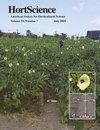二倍体和四倍体白芷的形态特征和耐旱性
IF 1.5
3区 农林科学
Q2 HORTICULTURE
引用次数: 0
摘要
当归(Angelonia angustifolia)是热带和亚热带地区广泛使用的一种重要盆栽花卉或被子植物。然而,大多数 Angelonia 栽培品种的花朵相对较小,在根系受限的环境(如小型容器)中表现出有限的耐旱性。多倍体植物通常花朵更大,耐旱性更强。在本研究中,分别用 0.1% 和 0.2% 的秋水仙素处理 Angelonia 'Serena White' 种子和'Serena Purple'幼苗,以诱导多倍体株系。与二倍体'Serena White'和'Serena Purple'植物相比,产生的四倍体花粉和花朵更大,叶片更厚、更绿,边缘呈锯齿状,气孔更长,气孔密度更低。与经过 40% 容积含水量(VWC)处理的植株相比,经过 20% 容积含水量(VWC)处理的二倍体和四倍体植株的叶片更小、SPAD-502 读数更高、花朵数量更少。此外,在 20% 和 40% VWC 条件下,四倍体的光合速率都高于二倍体。在 0.8 升的容器中生长时,即使在 20% 的 VWC 处理条件下,四倍体植株所需的浇水次数也比二倍体植株少,而且茎更粗壮、直立,花朵更大。秋水仙素诱导的多倍体化是提高当归耐旱性的有效方法。本文章由计算机程序翻译,如有差异,请以英文原文为准。
Morphological Characteristics and Drought Tolerance of the Diploid and Tetraploid Angelonia angustifolia
Angelonia (Angelonia angustifolia) is an important potted flowering plant or bedding plant widely used in tropical and subtropical regions. However, most Angelonia cultivars have relatively small flowers and demonstrate limited drought tolerance in root-restricted environments such as small containers. Polyploid plants often exhibit larger flowers and enhanced drought tolerance. In this study, Angelonia ‘Serena White’ seeds and ‘Serena Purple’ seedlings were treated with 0.1% and 0.2% colchicine to induce polyploid lines, respectively. The resulting tetraploids had larger pollen and flowers, along with thicker, greener leaves distinguished by serrated edges, longer stomata, and lower stomatal density compared with diploid ‘Serena White’ and ‘Serena Purple’ plants. Both diploid and tetraploid plants subjected to a 20% volumetric water content (VWC) treatment exhibited smaller leaves, higher SPAD-502 readings, and a decreased number of flowers compared with those subjected to 40% VWC treatment. Moreover, tetraploids had higher photosynthetic rates than diploids under both 20% and 40% VWC conditions. When grown in 0.8-L containers, tetraploid plants required fewer watering events and had thicker, erect stems with larger flowers than diploids, even under a 20% VWC treatment. Colchicine-induced polyploidization presents a promising method to potentially enhance drought tolerance in angelonia.
求助全文
通过发布文献求助,成功后即可免费获取论文全文。
去求助
来源期刊

Hortscience
农林科学-园艺
CiteScore
3.00
自引率
10.50%
发文量
224
审稿时长
3 months
期刊介绍:
HortScience publishes horticultural information of interest to a broad array of horticulturists. Its goals are to apprise horticultural scientists and others interested in horticulture of scientific and industry developments and of significant research, education, or extension findings or methods.
 求助内容:
求助内容: 应助结果提醒方式:
应助结果提醒方式:


